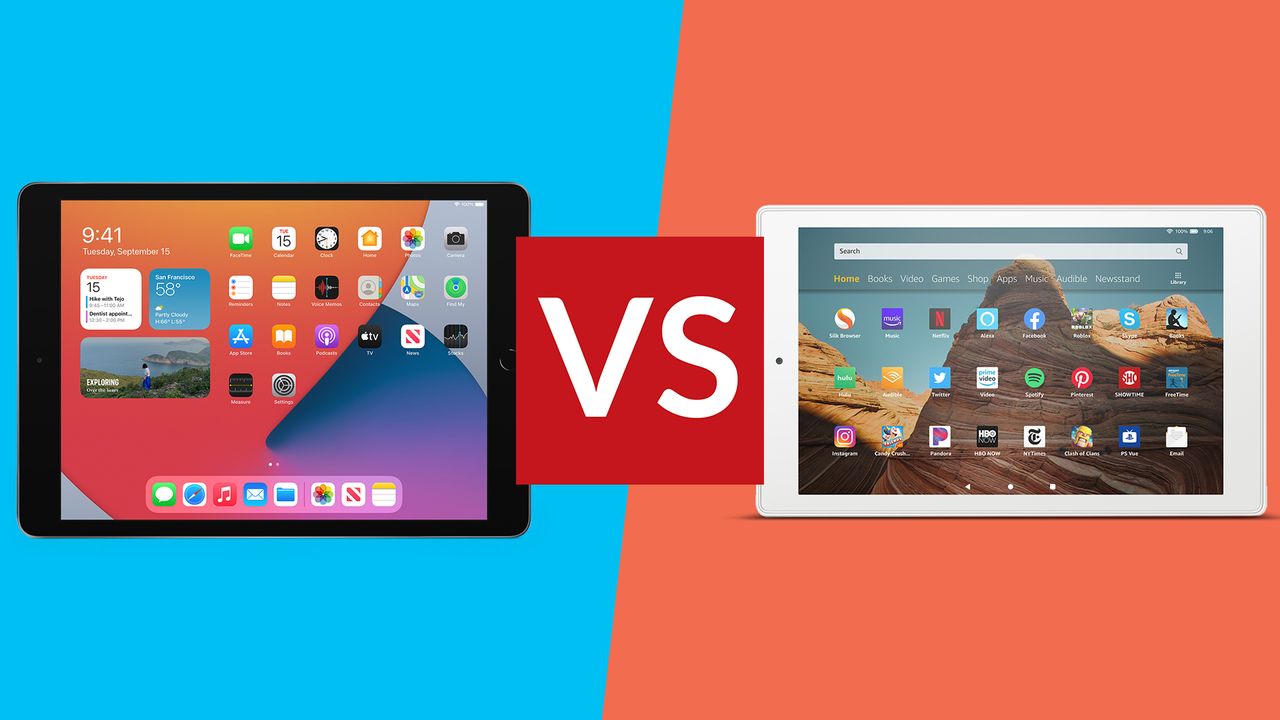

The iPad 10.2-inch (2020) is Apple’s cheapest iPad (since replaced by the 2021 iPad with uprated processor and True Tone screen), and it’s a superb all-rounder with excellent software, apps and build quality. It's easily one of the best tablets when it comes to capability and value.
But while it’s cheap by Apple standards, it’s still twice the price of the similar-size Amazon Fire 10 HD. The Apple and Amazon tablets are great slates if you need a full-size device without breaking the bank, but the differences between them go beyond the difference in their price tags.
Let’s explore the key features, strengths and weaknesses of each in this Apple versus Amazon showdown...
iPad 10.2 (2020) vs Amazon Fire HD 10: Design and display
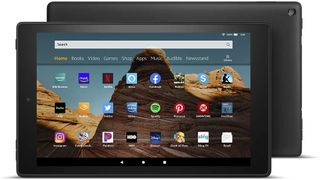
The Fire HD 10 isn't the most beautiful tablet, but the screen is solid for the price.
The iPad has a 10.2-inch Retina display delivering 2160x1620 pixels at 500 nits of brightness, which is excellent for the money. It supports the first-generation Apple Pencil, which is great for drawing and photo apps as well as for handwriting input.
The design is getting on a bit – this generation of iPad looks a bit heavy at the ends compared to the current iPad Air (2020), which has significantly smaller bezels thanks to a relocated Touch ID sensor – but it still looks good, is built to a premium standard, and comes in the familiar trio of silver, space grey or gold finishes. There are speakers at once end, which– as our seven-year-old associate tester is demonstrating while we type this – are surprisingly loud for such a small device. They’re best suited to speech but they’re surprisingly punchy with music, especially electronic music.
The display in the Fire HD 10 is 10.1 inches with a resolution of 1920x1200 pixels. It’s not quite as sharp as Apple’s higher-resolution screen, but it’s not bad for the money, with decent colour reproduction and contrast that makes it fine for box set binging on Prime Video. It's more widescreen than the iPad's display, which means that video fills its size better than the iPad, though browsing in apps and online is slightly easier with the iPad's taller screen.
The Fire boasts Dolby Atmos sound, but we think that’s a gimmick in a tablet with tiny speakers. Sound is clear, if a little lightweight and can sound harsh at higher volumes.
Sign up to the T3 newsletter for smarter living straight to your inbox
Get all the latest news, reviews, deals and buying guides on gorgeous tech, home and active products from the T3 experts
iPad 10.2 (2020) vs Amazon Fire HD 10: Performance and storage
This iPad has Apple’s A12 Bionic chip, a six-core processor with quad-core GPU that you'll also find in the iPhone XR, and a more powerful version of which is in the iPad Pro (2020). It’s not as fast as the A14 in the iPad Air (2020), but it’s still extremely responsive and more than capable of powering pro-level apps – its performance in benchmarks is better than most budget laptops. It’s teamed with either 32GB or 128GB of storage and 3GB of RAM.
The Fire HD 10 comes with 32GB or 64GB of storage and can be extended up to 512GB with a memory card. Its processor is a 2.0GHz Mediatek octa-core processor with 2GB RAM and an ARM Mali-G72 GPU. It isn’t as fast or as smooth as the iPad but it’s just fine for everyday apps and typical tablet gaming.
iPad 10.2 (2020) vs Amazon Fire HD 10: Cameras
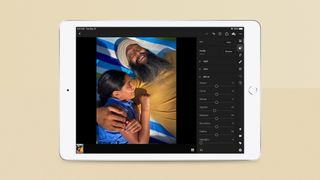
The camera in this iPad isn't Apple's best, but it's much better than the one in the Fire.
It’s clear that for Apple and Amazon the cameras were obvious corners to cut in order to keep the price down. But an Apple camera that isn’t quite top of the range is not necessarily a bad camera. The main camera in the iPad is 8MP with up 1080p HD video recording, image stabilisation and body and face detection. It’s several years behind the cameras in recent iPhones such as the iPhone 12 and the current, more expensive iPads, but it’s perfectly acceptable for shooting the odd home video or using augmented reality in apps.
The front-facing camera is 1.2MP with Retina Flash for better-lit selfies, and while it’s pretty mediocre overall, it's perfectly fine for the Zoom calls and the like.
The cameras are a bit of an afterthought in the Fire HD: there’s 2MP front and rear cameras capable of recording video at 720p. The cameras are fine for video calls but underpowered for photography, where the image quality is pretty weak.
iPad 10.2 (2020) vs Amazon Fire HD 10: Connectivity and battery life
The Fire HD 10 has a USB-C charging port capable of a full charge in just three hours if you connect it to a 15W power adapter, although the adapter in the box is 9W and takes four hours. Amazon says you should expect 12 hours of reading or web browsing between charges.
The Fire’s wireless is dual-band 802.11 up to and including 802.11ac. It also has Bluetooth.
The Wi-Fi in the iPad is also dual-band up to 802.11ac, but the Apple device also has HT80 with MIMO for faster connections (which mean faster downloads and streaming if you have a recent router) and you can specify your iPad with 4G LTE as well as Wi-Fi, if you want. Bluetooth 4.2 is on-board too.
Apple has moved its other iPads to USB-C, but this one retains the Lightning connector for connectivity and charging. Apple promises the usual 10 hours of web browsing or video between charges that it does for all iPads. The supplied power adapter is 20W, and it charges quickly.
iPad 10.2 (2020) vs Amazon Fire HD 10: Operating system and apps
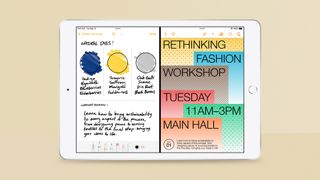
iPadOS has good multitasking features plus keyboard, mouse and Apple Pencil support.
The Fire HD 10 runs Amazon’s own version of Android. Fire OS 7 is based on Android 9 Pie and is largely a reskin of the Google OS with Amazon’s own App Store where you’d normally see the Google Play Store. You’ll find tutorials showing how to access the Play Store online. Fire OS 7 is pleasant enough, although it’s a bit dark for our tastes.
Amazon’s App Store contains all the big hitters you’d expect but it has a smaller selection than Apple and doesn’t offer the editorial selection and curation of the iPadOS App Store. Apple’s version feels like being in a lush department store; Amazon’s is more like your local store.
The iPad runs iPadOS, the big-screen sibling of iOS: they’ve been split into two different operating systems as the lines between iPads and laptops have grown ever more blurry. iPadOS enables you to use keyboards, trackpads and mice if you want these days, and it has some strong visual similarities with macOS Big Sur. However, it's still a touchscreen-first system at heart.
If you’re considering either of these tablets for work the iPad has much stronger multitasking capability, with its split-screen and divided screen views coming in particularly handy for working between apps. It also has the aforementioned 1st-gen Apple Pencil support, which is really good for creative apps and note-taking, and there are iPad versions of Apple’s Mac apps such as Pages and Numbers so you can work seamlessly across different Apple devices.
If you’re buying a tablet for kids, both of these devices have excellent parental controls including per-app limits and time limits.
iPad 10.2 (2020) vs Amazon Fire HD 10: Price and verdict
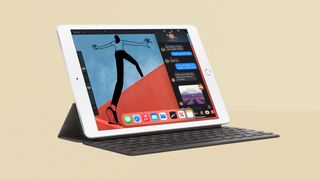
The iPad 10.2 (2020) starts at $329 / £329 / AU$499 for the 32GB model, rising to $429 / £429 / AU$649 for the 128GB model. The Wi-Fi and Cellular model is $459 / £459 / AU$699 for 32GB or $559 / £559 / AU$849 for 128GB.
The Fire HD 10 is much cheaper: the RRP is $149.99 / £149.99 for the 32GB model with advertising and $189.99 / £179.99 for the 64GB, but at the time of writing Amazon is discounting its devices for an even better deal. If you want to remove the advertising from the Lock Screen that’s an extra $10/£10.
If you want a 10-inch tablet for movies and other media consumption and your only concern is price, buy the Fire. It’s a solid device that covers the basics, but it has clearly been designed primarily as a device for consuming rather than creating content.
That accusation was levelled against the original iPad but it’s lost its sting as the iPad has evolved: there’s far more to the iPad than just sitting with it on the sofa. It’s an excellent all-rounder and while it costs more, its better specification and build quality mean you should get more useful years from it. It can be a light games and media machine, but it can do just about anything else on it too – it runs the exact same software as the iPad Pro, after all…
Writer, musician and broadcaster Carrie Marshall has been covering technology since 1998 and is particularly interested in how tech can help us live our best lives. Her CV is a who’s who of magazines, newspapers, websites and radio programmes ranging from T3, Techradar and MacFormat to the BBC, Sunday Post and People’s Friend. Carrie has written more than a dozen books, ghost-wrote two more and co-wrote seven more books and a Radio 2 documentary series; her memoir, Carrie Kills A Man, was shortlisted for the British Book Awards. When she’s not scribbling, Carrie is the singer in Glaswegian rock band Unquiet Mind (unquietmindmusic).
-
 Meze Audio’s new premium planar headphones will make you pen a poem
Meze Audio’s new premium planar headphones will make you pen a poemThese high-end hybrid over-ears are "more than just a headphone"
By Carrie Marshall Published
-
 Girard-Perregaux’s new Aston Martin collaboration boasts a green dial made from automotive paint
Girard-Perregaux’s new Aston Martin collaboration boasts a green dial made from automotive paintThe Girard-Perreagaux x Aston Martin collab has everything I like in a watch
By Bethan Girdler-Maslen Published